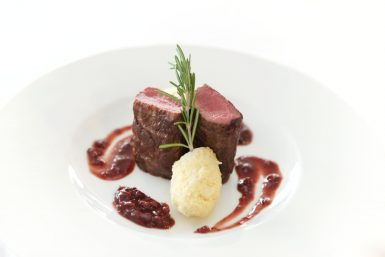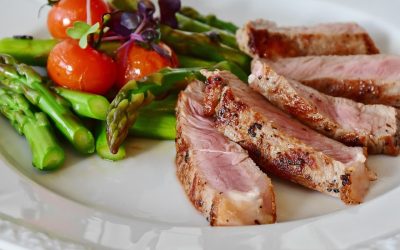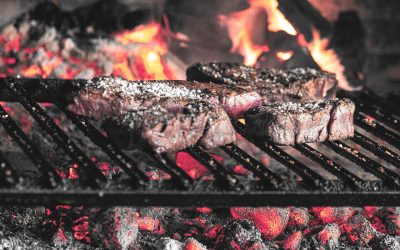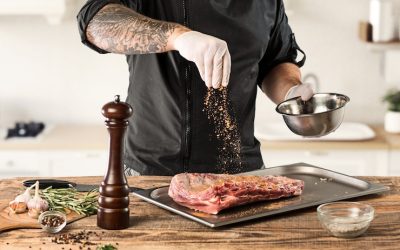Steak that tastes like meat. Or steak like a caress: soft, sincere, and light. Meat lovers who depend on it look for it in a restaurant if they want to get up from the table happy, with that feeling of fullness that is inherent not only in the stomach but also in life.
Maremma meat steak
One of the most famous is the Maremma breed. Bright red in color, it is especially often used in stews, given the leanness of the meat and the flavor, which is certainly not lacking. Another advantage of cooking steak with Maremma meat is that it loses little water during cooking. A rare thing.
The Maremma breed offers a unique culinary experience with its bright red, lean meat. It’s a popular choice for stews, where its robust flavor shines. An interesting aspect of Maremma meat is its minimal water loss during cooking, which is relatively uncommon in other meat types. This characteristic ensures that steaks retain their richness and full-bodied taste, making them a favorite among chefs for their consistency and reliability in various dishes. The Maremma meat’s ability to retain moisture also means it absorbs marinades well, enhancing its natural flavors.
Meat steak Chianina
By definition, Florentine steak is very valuable and lean but with an emphasized marbling near the muscles. The best, most tender, and compact meat is obtained from female cattle – Scotties.
The Florentine steak, derived from the Chianina breed, is renowned for its quality. Notably, the female cattle of this breed provide meat that’s both tender and richly marbled, contributing to a more flavorful experience. This marbling near the muscles enhances the juiciness of the steak, making it a prized choice for steak lovers.
The Chianina breed’s meat is known for its fine texture and the ability to maintain its integrity during cooking, which is why it’s often selected for premium steak dishes. Its lean nature, coupled with subtle marbling, offers a balance of taste and texture that is hard to find in other breeds.
Roma meat
Rarely available, but with a distinct and refined flavor, especially in ribs, it is recognized by its characteristic intense pink color.
Roma meat, though less commonly available, is distinguished by its intense pink hue and refined taste, particularly noticeable in rib cuts. This breed’s meat stands out for its unique flavor profile, which is both rich and subtle, making it a sought-after choice for culinary connoisseurs. The rarity of Roma meat adds to its allure, often making dishes prepared with it a special treat. Its distinct flavor is best showcased in simple preparations, allowing the natural taste of the meat to be the star of the dish.
Meat of the style
Another very valuable breed whose lean meat enchants enthusiasts with its delicate and sweet flavor. It is especially suitable for cuts and fillets.
This breed’s lean meat is a culinary delight, known for its delicate and sweet flavor. It is particularly suited for delicate cuts and fillets, where the meat’s inherent qualities can be fully appreciated. The Style meat is often the choice for dishes where the natural taste of the meat needs to stand out without overwhelming the palate. Its tenderness and flavor profile make it a versatile choice for various cooking methods, from grilling to slow-cooking.
THE BEST CUTS FOR STEAK
First-class cuts. Despite the names varying from region to region, we can identify those that are valued as first-class cuts. They are usually obtained from the cattle’s dorsal lumbar region and thigh. The steaks are excellent, especially when cooked on the grill. They are lean and very tender, thanks to the small amount of connective tissue present in the cuts of origin.
These top-tier cuts are typically from the cattle’s dorsal lumbar region and thigh. Recognized for their leanness and tenderness, these cuts are ideal for grilling, where their minimal connective tissue allows for a succulent and flavorful steak. First-class cuts are versatile and can be prepared in various styles, from rare to well-done, while maintaining their inherent quality. These cuts are also excellent for experimenting with different marinades and seasonings, as their texture and flavor absorb and complement added ingredients well.
Loin. Another piece that can bring satisfaction to those who are obsessed is the loin or, to be clear, given that the name may vary from region to region, the back of the cattle. Steaks come from the backside. Ribs, on the other hand, are from the front.
The loin, or the cattle’s back, is another exceptional piece for steak enthusiasts. Steaks from this area are known for their tenderness and flavor. The rib cuts from the front are equally delectable, offering a different texture and taste profile. The loin’s positioning on the animal contributes to its fine texture, as this area is less worked, resulting in softer meat. It’s a versatile cut that can be cooked in various ways, satisfying a range of palates.
Fillet. The famous fillet, placed under the loin, produces sliced steaks that are very tender due to the richness of the juices.
Positioned under the loin, the famous fillet yields sliced steaks known for their tenderness and juiciness. The richness of the juices in the fillet enhances the steak’s flavor, making it a popular choice for those seeking a luxurious dining experience. The fillet’s fine grain and soft texture make it a favorite for steak lovers and chefs alike. It’s a cut that requires minimal seasoning to bring out its natural, exquisite taste.
The upper part and croup . The outer back of the thigh should certainly not be neglected by those looking for great steaks. This is the rump. Except for the rump. The top and tubercles are ideal for making roast beef, stews and roasts.
The outer back of the thigh, or the rump, is an essential part for steak connoisseurs. The top and tubercles of the rump are ideal for roast beef, stews, and roasts, providing a rich and flavorful base for these dishes. The meat from this area is known for its balance of tenderness and flavor, making it a versatile choice for various cooking methods. Its robust nature makes it suitable for longer cooking times, allowing the flavors to develop fully.
Flat iron steak
The “top blade steak” cut produces delicious steaks, the advantage of which is that they are much cheaper than fillets but have similar characteristics.
This cut offers delicious steaks at a more affordable price than fillets. Its similarity in characteristics to fillets makes it a great alternative for those looking for quality without the high cost. The flat iron steak is celebrated for its marbling and tenderness, making it a popular choice for grilling and pan-searing. Its affordability and quality have made it a staple in many households and restaurants alike.
Steak chuck
“Chuck” in the sense of the neck. The neck of a bull. Because it’s not the source of disgusting and budget-friendly steaks.
Contrary to some perceptions, chuck steaks can be quite delectable when prepared correctly. The meat from the neck is characterized by its rich flavor and versatility in cooking. It’s suitable for slow-cooking methods, which help tenderize the meat and bring out its robust taste. Chuck steaks are an excellent choice for hearty meals and are often used in stews and braises.
Denver steak
Originating from the beef shoulder, Denver steaks are known for their tenderness and soft texture. These steaks offer a delightful eating experience, combining flavor with a melt-in-your-mouth quality. The shoulder cut provides a balance of meat and fat, contributing to the steak’s juiciness and taste. Denver steaks are a hidden gem in the steak world, offering a combination of quality and value that is hard to beat.
Ribeye steak
With its high-fat content, ribeye steak is known for its tenderness and rich flavor. This cut, derived from cattle, is a favorite among steak lovers for its marbling and succulence. The fat marbling in ribeye steaks contributes to their moist and flavorful nature, making them a popular choice for grilling and pan-searing. Ribeye steaks are often the centerpiece of a luxurious meal, offering a satisfying and indulgent dining experience.
New York strip steak
A staple in many restaurants, the New York strip steak is known for preparing very tender fillet steaks. This cut is favored for its balance of lean meat and fat, providing a perfect blend of flavor and texture. The New York strip is versatile and can be cooked to various levels of doneness while maintaining its quality. It’s a cut that appeals to a wide range of tastes, making it a popular choice in both home kitchens and fine dining establishments.
Brisket
Brisket is tenderized by extreme cooking methods, such as barbecue, with the benefit of the typical smoked flavor. Brisket is a cut that’s not too fatty and requires extensive cooking methods to tenderize, such as barbecuing. This cooking style imparts a distinctive smoked flavor, enhancing the meat’s natural taste. Brisket is known for its rich, deep flavor, making it a favorite for slow-cooked dishes. Its texture transforms through prolonged cooking, resulting in a tender and flavorful meat that is perfect for barbecue and slow-roasting.
Bison meat
Bison, typically slaughtered at around 30 months and grass-fed, offers lean yet tender meat full of flavor, rich in iron and protein. Bison meat’s unique taste profile sets it apart from traditional beef, offering a healthier alternative that doesn’t compromise on taste. The leanness of bison meat makes it a suitable option for those looking for a high-protein, low-fat diet. Its richness in nutrients and distinct flavor has made bison meat increasingly popular among health-conscious consumers and culinary enthusiasts.
Angus
Angus fillet is a real delicacy, certainly one of the best meat dishes in the world. For its flavor and nutritional properties. The animals grow in excellent conditions due to the richness of limestone in the land, which makes the grass more nutritious. And, obviously, because of the number of available fields and areas, as well as the frequency of rain.
The effect produced on the steaks improves the flavor with the advantage of a greater wealth of valuable nutrients such as essential fatty acids.
There are also a large number of cuts, among which stands out one of the most valuable, the Hereford Scotch.
Meat chef of restaurants
Every restaurant that wants to define itself as specialized in meat has its own meat chef, or butcher specialist, or chef de cuisine, i.e. a person to talk to, in the meat case.
The chef is the middle figure between the kitchen specialist responsible for the meat line in the kitchen and the ambassador of taste for the customers he receives and to whom he explains the features, types and origin of meat.
The chef ensures that all the meat on the menu is properly selected and cooked in accordance with restaurant standards. And at the same time, accepting, informing and guiding the customer’s choice, translating their wishes and offering solutions from the menu.
This type of person has extensive knowledge of the topic, from the origin of the meat, the type of breeding, feeding, age of slaughter, to all types of cooking: “grill, oven, charcoal, high temperature, pan” and cooking time.
It is not surprising that people who visit a restaurant and eat juicy steaks want to have fun afterwards. They like to play games of chance with pleasure and enjoyment, such as kasyno online szybkie wyplaty https://mojapamiatka.pl/kasyno/szybkie-wyplaty/.
Recent Posts
- Impressive steaks in restaurants
- Lovers and connoisseurs of marbled beef steaks
- Dress for Success: What to Wear to Ruth’s Chris Steak House
- What is the history of the origin of the steak. The dish comes from antiquity as it has changed over time
- Aussie Beefsteak: Cooking with Vegas Online Casino Star
About Beef Steak House

Beef Steak House is a legendary establishment of the famous international chain. This real man’s materia has become a kind of Mecca for fans and connoisseurs of American marbled beef steaks.


